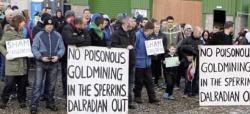By Harry Hutchinson, Labour Party NI
Northern Ireland holds huge gold, silver, copper, cobalt and other precious metals in its soil. According to the Chief Executive of Dalradian, one of the main prospecting companies, Curraghinalt Gold, in an area of the Sperrin Mountains north of Omagh, is “one of the best gold projects on the planet”. The areas has an estimated worth of $1.8bn in gold alone.
Five companies hold 10 mineral prospecting licences in different locations in a 100 square mile mountainous area of outstanding natural beauty and four of these companies have applied for planning from the Department of Economy, to commence mining. The mineral rights belong to the Crown Estate who will receive 15% of all profits.
Canadian-based Dalradian has spent over £60m in drilling and soil-sampling over the last 8 years and they have employed a London-based PR firm Blytheweigh to promote mining in the area.
The PR campaign has quickly set about bring on board politicians, community activists, church ministers and the local media to push the benefits of mining. One local priest was sent on an expenses-paid trip to Spain. The company has promised huge financial benefits from mining in the area, including up to 350 full time and other jobs. The local college was even encouraged to include skills related to mining in their curriculum. The local newspapers were rewarded with expensive advertising to promote mining. Some farmers were paid to sign contracts allowing mining on their lands.
Unfortunately, these empty promises have caused some divisions between anti-mining activists and those who are supportive of prospecting.
Cyanide danger to local environment
The mining process will involve the use of toxic compounds, including cyanide. In the process known as “leaching”, cyanide is used to extract gold and other metals from the rock. The residue is stored in lakes. As everyone knows, cyanide is a dangerous, toxic chemical. As well as potential spills, cyanide can be inhaled and ingested, where only a small amount can cause death. Fish and other river species are particularly susceptible to cyanide. More concerning is a cyanide plant is to be built close to a main reservoir that supplies a major town at the edge of the Sperrin Mountains.
The EU Parliament passed a resolution in 2010 (although not ratified by the EU Commission), to ban cyanide in mining processes, claiming that 30 major incidents have occurred world-wide in the last 25 years. The worst incident was the Baia Borsa dam in Romania in 2000, where after heavy rain and snow, a dam burst its banks, resulting in contamination of the drinking water of 2.5m people in neighbouring Hungary and Serbia.
Several anti-mining groups have sprung up to defend Northern Ireland’s natural environment from this threat of destruction. Each group works separately to avoid infiltration from the mining companies. Hundreds of local people have attended meetings in the towns and villages in the area, with many passionate to get involved. Protesters in the west of the Sperrins have lodged themselves in a small caravan at the site where one mining plant is to be built.
People are aware the risk these mining companies pose to an area protected by the EU wide Natura 2000 as a site of “special scientific interest”. The labour movement must take up this issue: it is a working class issue and the safety and well-being of local communities should be paramount over the needs of private profit. If the labour movement campaigned effectively on the question of unemployment and the provision of decent jobs in Northern Ireland, there would be no possibility of slick PR firms conning people with empty promises about ‘jobs’.
January 11, 2019



